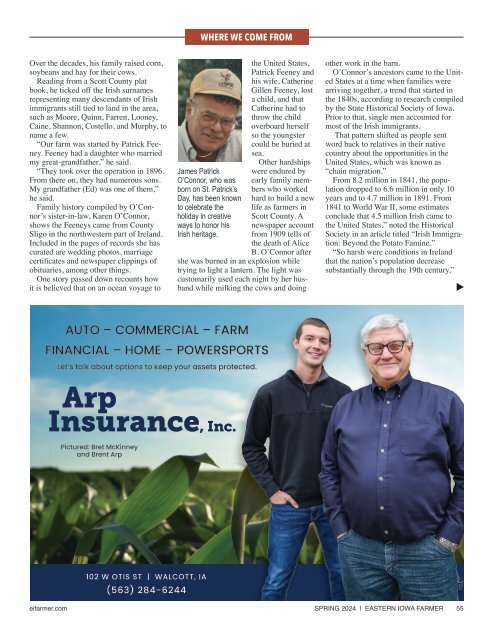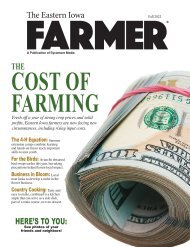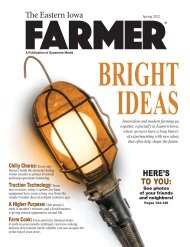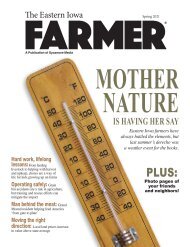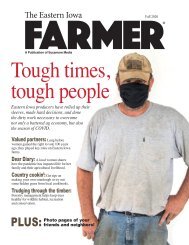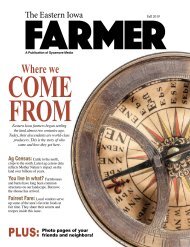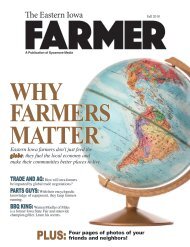Create successful ePaper yourself
Turn your PDF publications into a flip-book with our unique Google optimized e-Paper software.
WHERE WE COME FROM<br />
Over the decades, his family raised corn,<br />
soybeans and hay for their cows.<br />
Reading from a Scott County plat<br />
book, he ticked off the Irish surnames<br />
representing many descendants of Irish<br />
immigrants still tied to land in the area,<br />
such as Moore, Quinn, Farren, Looney,<br />
Caine, Shannon, Costello, and Murphy, to<br />
name a few.<br />
“Our farm was started by Patrick Feeney.<br />
Feeney had a daughter who married<br />
my great-grandfather,” he said.<br />
“They took over the operation in 1896.<br />
<strong>From</strong> there on, they had numerous sons.<br />
My grandfather (Ed) was one of them,”<br />
he said.<br />
Family history compiled by O’Connor’s<br />
sister-in-law, Karen O’Connor,<br />
shows the Feeneys came from County<br />
Sligo in the northwestern part of Ireland.<br />
Included in the pages of records she has<br />
curated are wedding photos, marriage<br />
certificates and newspaper clippings of<br />
obituaries, among other things.<br />
One story passed down recounts how<br />
it is believed that on an ocean voyage to<br />
James Patrick<br />
O’Connor, who was<br />
born on St. Patrick’s<br />
Day, has been known<br />
to celebrate the<br />
holiday in creative<br />
ways to honor his<br />
Irish heritage.<br />
the United States,<br />
Patrick Feeney and<br />
his wife, Catherine<br />
Gillen Feeney, lost<br />
a child, and that<br />
Catherine had to<br />
throw the child<br />
overboard herself<br />
so the youngster<br />
could be buried at<br />
sea.<br />
Other hardships<br />
were endured by<br />
early family members<br />
who worked<br />
hard to build a new<br />
life as farmers in<br />
Scott County. A<br />
newspaper account<br />
from 1909 tells of<br />
the death of Alice<br />
B. O’Connor after<br />
she was burned in an explosion while<br />
trying to light a lantern. The light was<br />
customarily used each night by her husband<br />
while milking the cows and doing<br />
other work in the barn.<br />
O’Connor’s ancestors came to the United<br />
States at a time when families were<br />
arriving together, a trend that started in<br />
the 1840s, according to research compiled<br />
by the State Historical Society of Iowa.<br />
Prior to that, single men accounted for<br />
most of the Irish immigrants.<br />
That pattern shifted as people sent<br />
word back to relatives in their native<br />
country about the opportunities in the<br />
United States, which was known as<br />
“chain migration.”<br />
<strong>From</strong> 8.2 million in 1841, the population<br />
dropped to 6.6 million in only 10<br />
years and to 4.7 million in 1891. <strong>From</strong><br />
1841 to World War II, some estimates<br />
conclude that 4.5 million Irish came to<br />
the United States,” noted the Historical<br />
Society in an article titled “Irish Immigration:<br />
Beyond the Potato Famine.”<br />
“So harsh were conditions in Ireland<br />
that the nation’s population decrease<br />
substantially through the 19th century,”<br />
AUTO – COMMERCIAL – FARM<br />
FINANCIAL – HOME – POWERSPORTS<br />
Let’s talk about options to keep your assets protected.<br />
Arp<br />
Insurance, Inc.<br />
Pictured: Bret McKinney<br />
and Brent Arp<br />
102 W OTIS ST | WALCOTT, IA<br />
(563) 284-6244<br />
eifarmer.com SPRING 2024 | EASTERN IOWA FARMER 55


